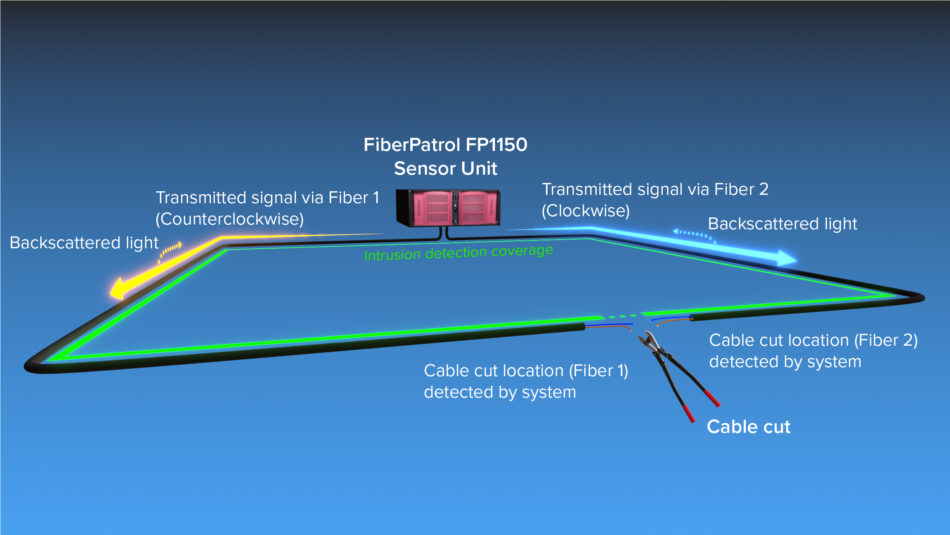The Evolution of Fiber Security System in Modern Security Solutions
The Evolution of Fiber Security System in Modern Security Solutions
Blog Article
The Ultimate Overview to Fiber Optic Security Solutions for Your Service
In a period where protection concerns are critical for organizations, recognizing the details of fiber optic technology can be transformative. This guide describes just how integrating fiber optic safety systems not only improves information protection but also provides benefits like resistance to disturbance and real-time tracking capacities.
Comprehending Fiber Optic Technology

The core of a fiber optic cable consists of a slim glass or plastic center, surrounded by a cladding layer that mirrors light back into the core. Single-mode fibers are created for long-distance transmission, while multi-mode fibers are appropriate for shorter distances, often used within buildings.
Optical fiber are not only faster yet also extra safe than typical electrical wiring. Their integral resistance to electro-magnetic disturbance and the problem of using the signal without detection make them a recommended choice for businesses focusing on data stability and safety and security. As companies significantly depend on protected and efficient communication systems, recognizing fiber optic technology ends up being crucial for notified decision-making.
Trick Benefits of Fiber Optic Protection
When considering safety choices for a business, the benefits of fiber optic systems are particularly engaging. First and leading, fiber optic modern technology supplies exceptional information transmission speeds and bandwidth capability, making it perfect for handling high-resolution video feeds from surveillance electronic cameras. This capacity makes sure that protection workers get real-time information, boosting total response times to possible safety dangers.
Furthermore, fiber optic cords are inherently immune to electromagnetic disturbance, which can endanger the honesty of typical copper-based systems. This resistance guarantees that the information transmitted stays safe and secure and continuous, providing a more trustworthy security framework. Furthermore, fiber optics are much less at risk to physical damages, as they are made from glass instead than steel, lowering maintenance costs and downtime.
Fiber optic systems supply enhanced cybersecurity attributes, consisting of security abilities that shield delicate data from unapproved gain access to. Jointly, these benefits make fiber optic safety systems a durable option for companies looking for to boost their safety measures.
Installment Refine and Considerations
Taking into consideration the complexities included, the setup process of fiber optic protection systems requires careful planning and execution. The preliminary action entails a comprehensive website evaluation to recognize optimum locations for cabling and devices. This evaluation needs to consider environmental factors, existing facilities, and potential susceptabilities.

In addition, the installment needs to abide with local building ordinance and market requirements. This may include coordinating with numerous stakeholders such as structure managers, IT groups, and protection workers to make sure seamless combination with existing systems.
Post-installation, strenuous testing is needed to verify system efficiency and determine any type of issues that might emerge. By prioritizing these factors to consider throughout the installation procedure, companies can ensure a durable and effective fiber optic safety and security system that satisfies their certain protection requirements.
Most Current Developments in Fiber Optic Protection
Current advancements in fiber optic modern technology have actually significantly enhanced the capabilities of fiber security system protection systems for organizations. One of the most remarkable advancements is the combination of fiber optic sensing units that can detect vibrations and intrusions along the border of a center. These sensing units offer real-time monitoring, enabling rapid feedback to potential violations.
Furthermore, the growth of distributed fiber optic picking up innovation enables the continual tracking of big areas with a single fiber cord. This method not only lowers installation expenses however also enhances the dependability of checking systems by eliminating the demand for multiple, separate sensing units.
Moreover, developments in multiplexing methods have made it possible for services to send large amounts of data over fiber optic networks, boosting the abilities of video clip monitoring systems. High-def video feeds can currently be sent over cross countries without loss of high quality, guaranteeing that safety and security personnel have access to clear and actionable details.
Lastly, using expert system (AI) together with fiber optic systems is transforming threat discovery. AI algorithms can evaluate data from fiber optic networks to determine uncommon patterns or behaviors, enabling for proactive security measures. These innovations collectively stand for a considerable leap ahead in fiber optic safety and security modern technology.
Choosing the Right System for Your Business
Picking the suitable fiber optic protection system for your company is vital for making sure ideal protection and comfort. To make an educated selection, examine your specific safety and security demands, thinking about variables such as the dimension of your facilities, the nature of your procedures, and potential susceptabilities.
Begin by evaluating the level of safety and security required; for instance, high-risk atmospheres might require advanced systems with incorporated monitoring and intrusion discovery capabilities. Next, take into consideration scalability; as your company grows, your safety system must can expanding to fit increased demands without significant overhauls.
In addition, explore the reliability and efficiency of different systems. Seek service providers with well-known track records and customer testimonials that prove to their solution quality. It's additionally a good idea to ask about the technology's compatibility with existing framework, guaranteeing a smooth assimilation process.
Final Thought
Finally, fiber optic safety systems offer a durable remedy for enhancing service safety facilities. The integration of high-speed data transmission, resistance to electro-magnetic interference, and advanced monitoring abilities significantly enhances overall security (fiber optic security system). By understanding the modern technology, recognizing its benefits, and taking into consideration the installation process, companies can make educated choices. The most recent advancements further bolster the effectiveness of these systems, guaranteeing that organizations remain safe and secure and versatile in an ever-evolving hazard landscape.
Report this page